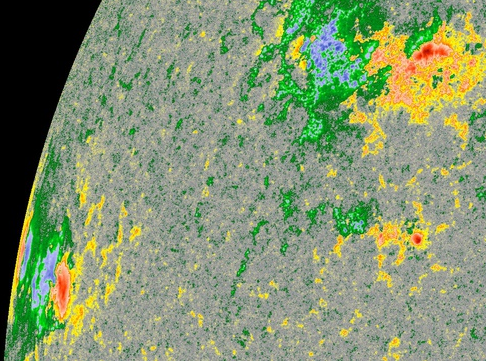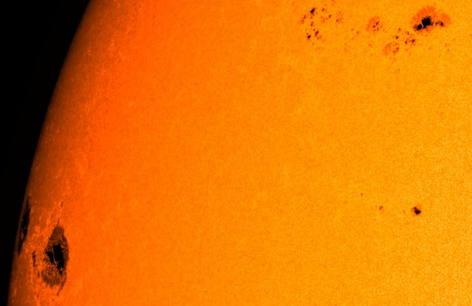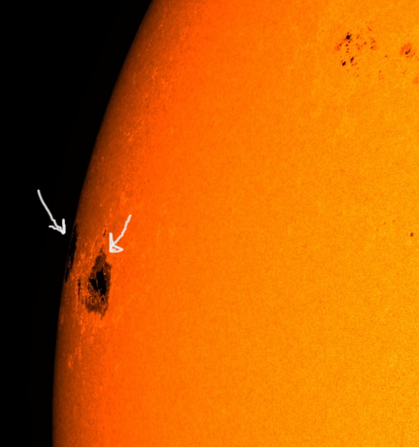It looks like you're using an Ad Blocker.
Please white-list or disable AboveTopSecret.com in your ad-blocking tool.
Thank you.
Some features of ATS will be disabled while you continue to use an ad-blocker.
share:
Originally posted by csuldm
When you zoom in on the image in the OP, it appears that there is another one on the "horizon" immediately to the left of the one originally brought up in this post, and it is just as big as the first one.
I am no Sun expert, so is that just a trick of the eye, or could there really be 2 massive spots right next to each other?
edit on 8-1-2013 by csuldm because: Added arrows to image showing the 2 spots I am talking about.
I was just coming back to post that! Wow!
This is going to be a monster group.
Wow.
Those are some huge spots.
Okay, for the paranoid on here, que JAWS music as they rotate into view:
Those are some huge spots.
Okay, for the paranoid on here, que JAWS music as they rotate into view:
I predict by the time this particular spot faces our direction, the activity will have basically all bit fizzled out. It's when activity starts at the
point we see the sun spot, that's we should keep our eyes open.
edit on 8-1-2013 by DAZ21 because: (no reason given)
This is happening just as it was prophesied back in 1983!
"There's a little black spot on the sun today. It's the same old thing as yesterday"
-Prophet Gordon Sumner

"There's a little black spot on the sun today. It's the same old thing as yesterday"
-Prophet Gordon Sumner

Something should be pointed out. The images being posted are HMI Intensitygrams. They are a representation of the strength and extent of magnetic
fields. In other words, we are not actually seeing sunspots.
To see actual sunspots you should be looking at something like this. If you were using a telescope in your backyard with a solar filter, this is what you would be seeing.
To see actual sunspots you should be looking at something like this. If you were using a telescope in your backyard with a solar filter, this is what you would be seeing.
edit on 1/8/2013 by Phage because: (no reason given)
HMI Colorized Magnetogram
HMI Intensitygram - colored


HMI Intensitygram - colored


edit on 8-1-2013 by MariaLida because: (no reason given)
As I said although big I really start to worry when I see something like this on the horizon as the sun goes down. Right now yes the one cresting is
large but as Phage said lacks the magnetics to really put on a show yet. Who can say now weather its going to decay or develop, lately they have
looked menacing only to start to decay as soon as earth facing. But as I said if I see one the size of the pic below then you'll have me a lil
worried.

Sanethinking

Sanethinking
edit on 8-1-2013 by SaneThinking because: (no reason given)
For everyones info I just google largest sun spots ever and found that pic as a representation of what "Huge" or "Massive" would look like. I
myself have only been really following the sun now for 4 or 5 yrs and just know that I have seen many in that time equally comparable to what could be
1654, but in terms of massive the one in my above post would truly be that.
SaneThinking
SaneThinking
reply to post by csuldm
I was waiting for the second one. They usually appear together. Heres why:
Why do sun spots come in pairs?
That is one hella big twisted rubber band there. Odds that it will snap directly at us are very low.
Can't wait to see the "magnetic rainbow" pics from this.
I was waiting for the second one. They usually appear together. Heres why:
Why do sun spots come in pairs?
That is one hella big twisted rubber band there. Odds that it will snap directly at us are very low.
Can't wait to see the "magnetic rainbow" pics from this.
Originally posted by intrptr
reply to post by csuldm
I was waiting for the second one. They usually appear together. Heres why:
Why do sun spots come in pairs?
That is one hella big twisted rubber band there. Odds that it will snap directly at us are very low.
Can't wait to see the "magnetic rainbow" pics from this.
Ah that's very interesting, I did not know that.
Thanks for hitting me with some knowledge!
reply to post by intrptr
From reading your link I don't think they are saying that "sunspots come in pairs" like another spot behind but I think the article is actually alluding to the fact each sunspot has a north and south polarity, a blue and red positive and negative polarity thus have a pair in a sense not so much the fact that where there is one another will form behind it. I could be wrong but thats what I got from your link.
For an illustration of this check out this HMI Colorized Magnetogram on the SDO which shows the "pair" within a sunspot ie. the blue and the red polar opposites. As I said could be wrong no expert but thats what I am grasping
SaneThinking
From reading your link I don't think they are saying that "sunspots come in pairs" like another spot behind but I think the article is actually alluding to the fact each sunspot has a north and south polarity, a blue and red positive and negative polarity thus have a pair in a sense not so much the fact that where there is one another will form behind it. I could be wrong but thats what I got from your link.
For an illustration of this check out this HMI Colorized Magnetogram on the SDO which shows the "pair" within a sunspot ie. the blue and the red polar opposites. As I said could be wrong no expert but thats what I am grasping
SaneThinking
edit on 8-1-2013 by SaneThinking because: spelling
Originally posted by rockymcgilicutty
Originally posted by Bluesma
www.spaceweather.com...That is Jupiter, Phage?? Seriously? I admit I am rather uneducated about these things. Is the way it looks flattened out an optical illusion ?
Do you really think that post was from Phage?
I have no idea, I dp not know Phage......I see no reason the name is important, I was responding to something that poster said, and I used the name he/she called him/her self.
It doesn't matter what they call themself.
But anyway, that was this morning and I guess this has been officially recognized.
Of greater interest, perhaps, is the large sunspot emerging just south of AR1652. Denoted by an arrow, the unnumbered region is crackling with C-class solar flares and, based on its size, could be capable of even stronger eruptions. We will know more in the days ahead as the sunspot turns toward Earth; a more direct view will reveal what kind of magnetic field the sunspot posseses.
www.spaceweather.com...
edit on 8-1-2013 by Bluesma because: (no reason given)
Latest SRS shows 1654 as a moderately sized group (260) with 2 sunspots and an Alpha configuration.
www.swpc.noaa.gov...
It's got a few days before it becomes geoeffective but at this point there doesn't seem to be much reason for concern
www.swpc.noaa.gov...
It's got a few days before it becomes geoeffective but at this point there doesn't seem to be much reason for concern
reply to post by Phage
Is there anywhere I could go to find a breakdown of what the info means on the llink you have provided. such as a legend to the table that is found through the link to better understand all that is being said there??
SaneThinking
Is there anywhere I could go to find a breakdown of what the info means on the llink you have provided. such as a legend to the table that is found through the link to better understand all that is being said there??
SaneThinking
reply to post by SaneThinking
SRS format:
www.swpc.noaa.gov...
Magnetic classification:
www.spaceweatherlive.com...
SRS format:
www.swpc.noaa.gov...
Magnetic classification:
www.spaceweatherlive.com...
reply to post by Phage
How does this one or two rate in terms of potential for disaster compared to others you have seen before? I ask because it almost feels like you are holding out reservations on this one compared to others int he past. I know you like to diffuse panic, and fear but this time just seems different.
How does this one or two rate in terms of potential for disaster compared to others you have seen before? I ask because it almost feels like you are holding out reservations on this one compared to others int he past. I know you like to diffuse panic, and fear but this time just seems different.
reply to post by antar
It's no big thing (as far as solar regions go).
As it is it really doesn't have much potential to produce much of anything. But that said, like storms on Earth, things can change.
It's no big thing (as far as solar regions go).
As it is it really doesn't have much potential to produce much of anything. But that said, like storms on Earth, things can change.
OOh great, well then I will just keep an eye on this thread for the next few days, Thanks!
reply to post by SaneThinking
Sun spots don't always come in pairs. Its more complex than that. Phage's link above describes the different types. Heres another one that talks a little more about it too.
solar.bnsc.rl.ac.uk...
And a bit of video that shows the magnetic field lines that emanate from the sun spots.
You can see the lay lines because they draw plasma from the sun up into them. Works kind of like a conductor, or a horeshoe magnet arranging iron filings into a "loop". One "end" of the loop is positive and the other negative. So a group, groups or pairs of spots appear on the sun at the base of the magnetic "rainbow". The earth has but two magnetic poles, the sun is filled with roiling and twisting masses like big magnetos that produce these fields and lay lines. The earths poles are constant, the sun's come and go.
Sun spots don't always come in pairs. Its more complex than that. Phage's link above describes the different types. Heres another one that talks a little more about it too.
solar.bnsc.rl.ac.uk...
And a bit of video that shows the magnetic field lines that emanate from the sun spots.
You can see the lay lines because they draw plasma from the sun up into them. Works kind of like a conductor, or a horeshoe magnet arranging iron filings into a "loop". One "end" of the loop is positive and the other negative. So a group, groups or pairs of spots appear on the sun at the base of the magnetic "rainbow". The earth has but two magnetic poles, the sun is filled with roiling and twisting masses like big magnetos that produce these fields and lay lines. The earths poles are constant, the sun's come and go.
edit on 8-1-2013 by intrptr because: correction
new topics
-
When an Angel gets his or her wings
Religion, Faith, And Theology: 24 minutes ago -
Comparing the theology of Paul and Hebrews
Religion, Faith, And Theology: 1 hours ago -
Pentagon acknowledges secret UFO project, the Kona Blue program | Vargas Reports
Aliens and UFOs: 2 hours ago -
Boston Dynamics say Farewell to Atlas
Science & Technology: 2 hours ago -
I hate dreaming
Rant: 2 hours ago -
Man sets himself on fire outside Donald Trump trial
Mainstream News: 4 hours ago -
Biden says little kids flip him the bird all the time.
2024 Elections: 5 hours ago -
The Democrats Take Control the House - Look what happened while you were sleeping
US Political Madness: 5 hours ago -
Sheetz facing racial discrimination lawsuit for considering criminal history in hiring
Social Issues and Civil Unrest: 5 hours ago -
In an Historic First, In N Out Burger Permanently Closes a Location
Mainstream News: 7 hours ago
top topics
-
In an Historic First, In N Out Burger Permanently Closes a Location
Mainstream News: 7 hours ago, 14 flags -
The Democrats Take Control the House - Look what happened while you were sleeping
US Political Madness: 5 hours ago, 13 flags -
A man of the people
Medical Issues & Conspiracies: 13 hours ago, 8 flags -
Biden says little kids flip him the bird all the time.
2024 Elections: 5 hours ago, 8 flags -
Man sets himself on fire outside Donald Trump trial
Mainstream News: 4 hours ago, 7 flags -
Pentagon acknowledges secret UFO project, the Kona Blue program | Vargas Reports
Aliens and UFOs: 2 hours ago, 4 flags -
4 plans of US elites to defeat Russia
New World Order: 14 hours ago, 4 flags -
Sheetz facing racial discrimination lawsuit for considering criminal history in hiring
Social Issues and Civil Unrest: 5 hours ago, 3 flags -
Are you ready for the return of Jesus Christ? Have you been cleansed by His blood?
Religion, Faith, And Theology: 10 hours ago, 3 flags -
MH370 Again....
Disaster Conspiracies: 8 hours ago, 2 flags
active topics
-
Election Year 2024 - Interesting Election-Related Tidbits as They Happen.
2024 Elections • 67 • : WeMustCare -
The Democrats Take Control the House - Look what happened while you were sleeping
US Political Madness • 53 • : Mahogani -
Candidate TRUMP Now Has Crazy Judge JUAN MERCHAN After Him - The Stormy Daniels Hush-Money Case.
Political Conspiracies • 401 • : WeMustCare -
So I saw about 30 UFOs in formation last night.
Aliens and UFOs • 36 • : Arbitrageur -
Thousands Of Young Ukrainian Men Trying To Flee The Country To Avoid Conscription And The War
Other Current Events • 48 • : Consvoli -
12 jurors selected in Trump criminal trial
US Political Madness • 110 • : DontTreadOnMe -
A man of the people
Medical Issues & Conspiracies • 10 • : Astrocometus -
When an Angel gets his or her wings
Religion, Faith, And Theology • 0 • : BrotherKinsMan -
-@TH3WH17ERABB17- -Q- ---TIME TO SHOW THE WORLD--- -Part- --44--
Dissecting Disinformation • 545 • : cherokeetroy -
Man sets himself on fire outside Donald Trump trial
Mainstream News • 31 • : watchitburn

